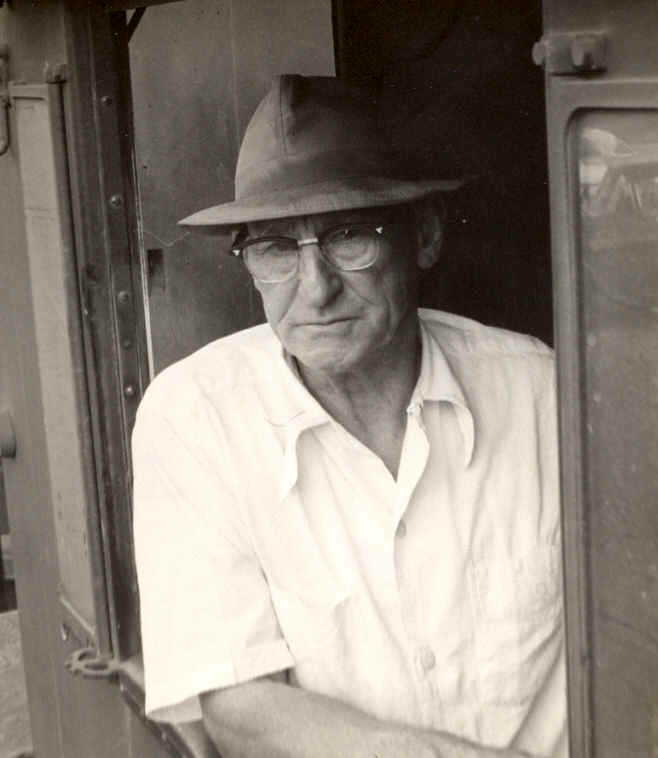
History of the Virginia Branch
(Known locally as the "Virginia Creeper.")(To go to "The Creation of the Virginia Creeper Trail" click here.)
Crossing South Holston Lake in 1965History of the Virginia Creeper
Before the biking trails and train rails were laid, Indians followed animal trails out of the Blue Ridge through the area to create a footpath westward. According to early records, Daniel Boone camped along the trail near Damascus as he traveled on his way to Kentucky. (Historians generally do not identify the current Creeper Trail as an Indian footpath.)By 1907, W.B. Mingea had constructed the Virginia Carolina Railroad from Abingdon to Damascus. In 1905 the line was extended by Hassinger Lumber Co. to Konnarock and Elkland, NC. It hauled lumber, iron ore, supplies and passengers.
The locals referred to the train that climbed eastward into the Iron Mountains as the "Virginia Creeper", a name taken from the native plant that grows along the route. A steam engine laboring up mountain grades with heavy loads of lumber, iron ore, supplies, and passengers was also a "virginia creeper" in every sense of the word.
Engineer Hughes takes the train
up the mountain in 1965.By 1918 the line stretched 75 miles to Elkland, North Carolina, and included more than 100 trestles. Villagers out picking blackberries or elderberries along the tracks watched as stacks of red spruce, freshly cut from virgin forests high atop Mount Rogers, rumbled by on flatbed cars. Although beset by flood damage as well as economic problems associated with the Great Depression, the Virginia Creeper ran its last train on March 31, 1977.
Today thousands of people from all over the world travel to the towns along the Virginia Creeper Trail to experience an outdoor adventure biking, hiking, birding, fishing, or just plain ol' relaxing. After a day filled with outdoor adventures vacationers find solice in the many wonderful dining, lodging and shopping opportunities in the area.
From Abingdon to Damascus, the trail right-of-way belongs to the two towns, but most of the actual land is private. While you do have the right to use the creeper trail across their property, please respect landowners. Stay on the Creeper Trail, close gates, keep your bicycles under control, keep dogs under control, don't frighten livestock and be friendly!
The Virginia Creeper Trail between Damascus and the North Carolina border, except for a short stretch through Taylor's Valley, is part of the Jefferson National Forest and is administered by the Mount Rogers National Recreation Area staff.
(History courtesy of creepertrailinfo.com.)
Virginia-Carolina Railway
From Wikipedia, the free encyclopediaThe Virginia-Carolina Railway was an interstate railroad in southwestern Virginia and northwestern North Carolina. It ran from Abingdon in Washington County, Virginia to Todd in Ashe County, North Carolina. The line charted a complicated course through the mountains of the area, crossing the Blue Ridge not far from Mount Rogers.
Construction of the railroad was begun in 1885 by the Abingdon Coal and Iron Railroad but the company folded before the railroad became operational. Construction was continued by the Virginia Western Coal and Iron Railroad, but financial difficulties persisted. Norfolk and Western sponsored the Virginia-Carolina Railway, which took over the line in 1898 and finally completed construction to Damascus in 1900. In 1907, the line had reached Taylor's Valley. The Hassinger Lumber Co., whose mill was seven miles away in Konnarock, built the Virginia-Carolina & Southern Railway to make this connection. Later, the V-C&S would be absorbed into the V-C, which used it as a branch line to the mill. The V-C was extended through the Blue Ridge to White Top in 1912 and to its terminus by 1920. Norfolk and Western absorbed the line 1919 and operated it as its Abingdon branch. Operations ceased in 1977 after flooding damaged portions of the track.
White Top Railway
From Wikipedia, the free encyclopediaThe White Top Railway was chartered as a common carrier in the early 20th century from a portion of the logging lines of the Hassinger Lumber Company in Washington and Grayson Counties, Virginia. The move was born of the lumber company's need to protect its rail operations at points of intersection with the Virginia-Carolina Railway from possible condemnation for the V-C's own, expanding line. (Both roads were vying for right-of-way through the narrow confines of the Laurel Creek gorge.)
The length of the WT was a scant 8 miles, covering the distance from the mill in Konnarock to the mountain village of White Top. This mileage represented a small percentage of Hassinger's 75 miles of logging line. The WT was built as a standard gauge line, although a third rail was added for two miles near the mill to accommodate narrow gauge trains acquired with the purchase of the T.W. Thayer Lumber Co. in 1924. Operations on the WT ceased upon or soon after the closing of the mill on Christmas Eve 1928.

